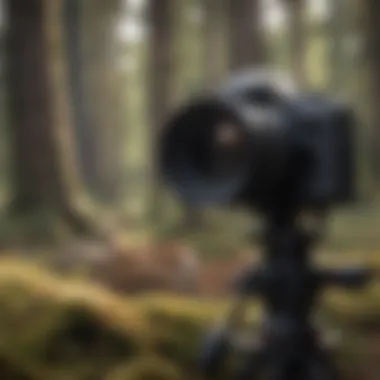Ultimate Guide to Embarking on Deer Hunting Journey


Overview of Deer Hunting
Deer hunting, a popular outdoor pursuit, involves hunters seeking deer for various reasons, including population control and sustenance. Understanding this activity's nuances is crucial for both novice and seasoned hunters.
Gear and Equipment
Selection of appropriate gear and equipment is paramount for a successful deer hunting expedition. Essential items include firearms, ammunition, hunting clothing, scent control products, and optics such as binoculars.
Pre-Hunting Preparation
Before heading into the woods, thorough pre-hunting preparation is essential. This involves scouting the hunting area, setting up trail cameras, understanding deer behavior patterns, and ensuring legal compliance with hunting regulations.
Hunting Techniques
Several hunting techniques can be employed in deer hunting, such as still hunting, stand hunting, deer drives, and stalking. Each technique requires precision, patience, and an understanding of deer behavior.
Safety and Ethical Considerations
Safety should always be a top priority in deer hunting. Adhering to firearm safety measures, respecting property rights, and following ethical hunting practices are crucial aspects of being a responsible hunter.
Impact on Ecosystems
Deer hunting plays a significant role in managing deer populations, which, if left uncontrolled, can have detrimental effects on ecosystems. An understanding of deer ecology and population dynamics is vital for sustainable deer management.
Conservation Efforts
Conservation efforts aimed at preserving deer habitats and promoting sustainable hunting practices are essential. Contributing to conservation organizations, participating in habitat restoration projects, and advocating for wildlife conservation are valuable ways to support deer populations and their ecosystems.
Conclusion
Introduction to Deer Hunting
Deer hunting, a time-honored tradition deeply rooted in human history, serves as a gateway to exploring the intricacies of the natural world. This section delves into the fundamental aspects of deer hunting, shedding light on its significance and allure for enthusiasts seeking a primal connection with the wilderness. From understanding the behavior of these majestic creatures to mastering the art of tracking and harvesting, the introduction sets the stage for a journey of skill development and environmental awareness.
Understanding the Basics
- Definition of Deer Hunting: The pursuit of deer for sustenance, sport, or wildlife management lies at the core of this time-tested practice. Defined by the pursuit of deer species using various methods, deer hunting embodies a blend of skill, patience, and respect for the environment. Embraced for its challenge and rewarding outcomes, deer hunting serves as a window into the intricate balance of predator-prey relationships in natural ecosystems, underlining the primal instinct of survival manifest in human endeavors.
- History and Evolution: Tracing its origins back to our ancestors' primal need for food and resources, the evolution of deer hunting mirrors humanity's journey from survival to recreation. Over centuries, deer hunting has transitioned from a means of subsistence to a regulated sport, reflecting changing attitudes towards wildlife and conservation. Understanding the historical context of deer hunting offers valuable insights into societal values, ecological dynamics, and the adaptive nature of human activities in response to environmental shifts.
- Significance in Modern Times: In contemporary society, deer hunting plays a multifaceted role encompassing wildlife management, cultural heritage, and outdoor recreation. As regions grapple with issues of overpopulation and habitat encroachment, deer hunting emerges as a strategic tool for maintaining ecological equilibrium and preserving biodiversity. Moreover, the practice fosters a profound connection to nature, instilling a sense of responsibility towards environmental stewardship and sustainable resource utilization. By embracing ethical hunting practices, modern enthusiasts are actively contributing to the conservation and sustainable management of wildlife populations.
Legal and Ethical Considerations
- Licensing and Regulations: Upholding legal requirements and adhering to regulatory frameworks is paramount in the realm of deer hunting to ensure sustainable practices and maintain population health. Licensing mechanisms and hunting regulations serve as gatekeepers, promoting responsible hunting behavior and safeguarding wildlife populations from overexploitation. By obtaining permits and abiding by hunting quotas, hunters actively contribute to the preservation of species diversity and environmental balance.
- Conservation Ethics: Embedded within the ethos of deer hunting lies a deep-rooted commitment to conservation ethics, underscoring the intrinsic value of wildlife and ecosystems. By embodying principles of respect, integrity, and ecological mindfulness, hunters prioritize long-term sustainability over short-term gains. Through participation in habitat conservation initiatives and wildlife monitoring programs, ethical hunters exemplify a balanced approach towards resource utilization, emphasizing the interdependence between human activities and natural habitats.
- Fair Chase Principles: Central to the ethos of ethical hunting is the concept of fair chase, advocating for a level playing field between hunters and their quarry. Guided by principles of sportsmanship and humane conduct, fair chase hunting encourages ethical engagement with wildlife, fostering a harmonious coexistence between predator and prey. By upholding fair chase standards, hunters demonstrate reverence for wildlife and uphold the integrity of the hunting tradition, aligning their actions with the principles of conservation and ecological sustainability.
Benefits of Deer Hunting
- Wildlife Population Management: Through regulated hunting practices, hunters contribute to the effective management of wildlife populations, mitigating ecological imbalances and supporting species health. By culling surplus deer and controlling herd sizes, hunters play a vital role in preventing overpopulation, minimizing habitat destruction, and safeguarding biodiversity. Wildlife population management through hunting emerges as a proactive conservation strategy, promoting ecosystem health and resilience through targeted intervention.
- Connection to Nature: Engaging in deer hunting offers enthusiasts a unique opportunity to immerse themselves in the natural world, forging a profound connection with the environment and its inhabitants. From experiencing the serenity of the wilderness to witnessing the beauty of wildlife up close, hunters cultivate a deep appreciation for nature's complexity and grandeur. The bond forged through hunting extends beyond the thrill of the chase, awakening a sense of stewardship towards the land and its resources.
- Sustainable Harvesting: Rooted in principles of sustainability, deer hunting advocates for responsible harvesting practices that prioritize resource longevity and ecological balance. By adhering to harvest limits, minimizing waste, and utilizing game meat for sustenance, hunters embody the principles of sustainable resource management. Sustainable harvesting not only ensures the continued availability of wildlife resources for future generations but also promotes ethical consumption patterns and reinforces the connection between humans and the natural world.
Essential Gear for Deer Hunting


Aspiring deer hunters must understand the critical role that essential gear plays in ensuring a successful and ethical hunting experience. From specialized clothing and footwear to firearms and hunting accessories, each item serves a crucial purpose in the field. Without the right gear, hunters risk compromising their safety, effectiveness, and adherence to ethical hunting practices.
Clothing and Footwear
Camouflage Apparel
Camouflage apparel is an indispensable component of a hunter's gear arsenal, designed to provide effective concealment in various hunting environments. The key characteristic of camouflage apparel lies in its ability to blend seamlessly with the natural surroundings, offering hunters a strategic advantage by minimizing their visibility to game animals. The unique feature of camouflage apparel is its pattern diversity, ranging from woodland to desert motifs, catering to different landscapes and seasons. While camouflage apparel enhances a hunter's stealth and hunting success, it is essential to consider its limitations in areas with distinct foliage patterns.
Insulated Boots
Insulated boots are essential for maintaining comfort and protecting against harsh weather conditions during prolonged hunting expeditions. The key characteristic of insulated boots is their thermal insulation properties, which keep feet warm in cold environments, ensuring hunters can focus on their pursuit without discomfort. The unique feature of insulated boots is their waterproof construction, preventing moisture penetration and enhancing durability in rugged terrains. While insulated boots provide crucial protection, their bulkiness may hinder mobility in certain terrains, requiring hunters to strike a balance between warmth and agility.
Scent Control Gear
Scent control gear plays a vital role in minimizing human odors that could alert deer to a hunter's presence, thereby increasing the likelihood of a successful hunt. The key characteristic of scent control gear is its ability to neutralize and mask odors through advanced technologies such as activated carbon and silver ions. The unique feature of scent control gear lies in its versatility, with options ranging from sprays to clothing infused with scent-blocking properties. While scent control gear enhances concealment, hunters must remain vigilant in avoiding other sources of contamination, such as food odors or exhaust fumes, to capitalize on its effectiveness.
Firearms and Ammunition
Hunters must carefully select the appropriate firearms and ammunition to match their hunting environment, target species, and shooting proficiency. Each element contributes significantly to the accuracy, range, and ethical considerations of the hunt, requiring thorough consideration and expertise in their utilization.
Rifles and Shotguns
Rifles and shotguns are primary tools for deer hunting, offering varying calibers and gauges to suit different hunting scenarios. The key characteristic of rifles lies in their long-range precision and bullet velocity, ideal for open fields and elevated stands. In contrast, shotguns excel in short-distance shooting and maneuverability in dense foliage, providing versatility in close encounters. The unique feature of rifles and shotguns is their customization potential through scopes and chokes, enhancing accuracy and impact. While rifles and shotguns empower hunters with effective shooting capabilities, proper training and adherence to safety protocols are paramount to prevent accidents and ensure ethical harvesting.
Ammunition Types
Selecting the appropriate ammunition is crucial to achieving quick, humane kills and minimizing suffering for game animals. The key characteristic of ammunition types lies in their design, including bullet weight, composition, and velocity, tailored to specific hunting applications. Common ammunition options range from hollow-point bullets for controlled expansion to polymer-tipped bullets for enhanced accuracy and penetration. The unique feature of ammunition types is their ballistic performance influenced by factors like bullet drop and wind drift, demanding precise shot placement for ethical hunting outcomes. While ammunition types influence hunting success, hunters must practice responsible shot placement and understand their chosen ammunition's ballistic behavior to ensure humane harvests.
Scope Selection
A quality scope enhances a hunter's shooting accuracy, increasing target acquisition speed and range estimation capabilities in the field. The key characteristic of scope selection is its magnification power and reticle design, enabling hunters to zoom in on targets and compensate for bullet drop. The unique feature of scope selection lies in its light-gathering abilities, crucial for low-light conditions during dawn and dusk hunts. While scopes offer precise aiming solutions, hunters must zero their scopes correctly, practice with different magnifications, and understand environmental factors' influence on shot placement to optimize their hunting experience.
Hunting Accessories
Complementing the essential gear, hunting accessories enhance a hunter's adaptability, communication with game animals, and overall safety precautions in the field. From optics for enhancing visual clarity to calls and decoys for luring targets, each accessory serves a specific purpose in the hunting process.
Optics (Binoculars, Range Finders)
Optics such as binoculars and range finders provide hunters with enhanced vision and accurate distance measurements for successful target identification and shot placement. The key characteristic of optics is their magnification power and lens quality, delivering clear and detailed images of distant objects. The unique feature of optics lies in their portability and durability, enabling hunters to scout terrain and spot game effectively. While optics offer invaluable assistance in scouting and hunting, hunters must practice proper glassing techniques, understand lens coatings' impact on image quality, and maintain optic cleanliness for optimal performance in the field.
Calls and Decoys
Calls and decoys serve as effective tools for attracting game animals by simulating natural sounds and visual cues, enticing curious or territorial behavior. The key characteristic of calls and decoys is their authenticity in replicating animal vocalizations and behaviors, enhancing the hunting experience. The unique feature of calls and decoys lies in their versatility, with options for different species and scenarios, from doe bleats to antler rattling. While calls and decoys offer strategic advantages in attracting game, hunters must practice proper calling techniques, understand local wildlife behavior patterns, and deploy decoys judiciously to avoid detection by wary animals.
Safety Equipment
Ensuring hunter safety is paramount in any hunting expedition, with safety equipment playing a crucial role in mitigating risks and responding to emergencies effectively. The key characteristic of safety equipment is its proactive approach to preventing accidents through visibility enhancements and emergency preparedness. The unique feature of safety equipment lies in its versatility, encompassing items like first aid kits, navigation tools, and communication devices for comprehensive safety coverage. While safety equipment fosters a secure hunting environment, hunters must undergo safety training, carry essential emergency supplies, and communicate their hunting plans with trusted contacts to prioritize personal well-being and operational readiness in the field.
Preparation for Deer Hunting


In this section, we delve into the crucial aspect of preparation for deer hunting. Adequate preparation is essential for a successful hunting experience, encompassing various elements that contribute to a hunter's readiness. One must meticulously plan and equip oneself before heading out into the wilderness in pursuit of deer. Effective preparation not only enhances the chances of a fruitful hunt but also ensures the safety and ethical practice of hunting. It involves acquiring the necessary skills, knowledge, gear, and physical conditioning to navigate the challenges of the hunting environment. Preparation for deer hunting sets the foundation for a fulfilling and responsible hunting expedition.
Scouting and Trail Cameras
Selecting Hunting Locations
When it comes to selecting hunting locations, attention to detail is paramount. The choice of hunting location can significantly impact the success of a hunt. Factors such as terrain, vegetation, deer behavior, and proximity to water sources play a crucial role in determining the suitability of a hunting spot. A well-chosen location provides ample opportunities for sightings and increases the likelihood of a fruitful hunt. Seasoned hunters often scout multiple locations to identify the most promising spots for deer activity, ensuring a strategic advantage during hunting sessions. Selecting hunting locations strategically is key to optimizing hunting outcomes.
Setting Up Trail Cameras
Setting up trail cameras is an invaluable practice in modern deer hunting methodologies. Trail cameras offer hunters the capability to monitor deer movement patterns, behaviors, and population dynamics discreetly. By strategically placing trail cameras in potential hunting locations, hunters can gather essential data that aids in decision-making for the actual hunting expedition. Surveillance through trail cameras provides valuable insights into deer habits, enabling hunters to adapt their strategies accordingly. Integrating trail cameras into hunting preparations adds a layer of sophisticated surveillance that enhances the overall hunting experience.
Interpreting Sign
Interpreting sign, such as tracks, droppings, rubs, scrapes, and other indicators of deer presence, is a skill every hunter must master. Understanding and interpreting these signs provide hunters with valuable information about deer behavior, feeding patterns, and movement routes. By analyzing and deciphering these signs, hunters can identify high-traffic areas, bedding zones, and potential ambush sites. The ability to interpret sign accurately improves a hunter's capacity to anticipate deer movements and strategically position themselves for a successful hunt. Mastery of interpreting sign is a fundamental aspect of effective deer hunting preparation.
Physical Conditioning
Endurance Training
Endurance training plays a vital role in preparing hunters for the physical demands of the hunting excursion. Building endurance enables hunters to trek long distances, withstand harsh weather conditions, and maintain focus during extended periods in the wilderness. Endurance training enhances cardiovascular health, boosts stamina, and improves overall physical resilience. By engaging in activities like jogging, hiking, or cycling, aspiring hunters can enhance their endurance levels and prime their bodies for the rigors of hunting expeditions. Incorporating endurance training into preparation routines is essential for optimizing performance in the field.
Strength and Flexibility Exercises
Strength and flexibility exercises are integral components of physical conditioning for deer hunting. Strong muscles and limber joints contribute to better agility, balance, and maneuverability in challenging terrains. Strength training exercises, including weightlifting or bodyweight exercises, build muscle mass and increase overall physical strength. Flexibility exercises like yoga or stretching routines improve range of motion, preventing injuries and enhancing mobility during hunts. By focusing on strength and flexibility enhancement, hunters can enhance their physical preparedness for the demands of deer hunting.
Nutrition and Hydration
Proper nutrition and hydration are cornerstones of physical preparation for deer hunting. Maintaining a balanced diet rich in proteins, carbohydrates, and essential nutrients fuels the body for strenuous activities in the wild. Adequate hydration ensures optimal physical performance, mental alertness, and endurance during lengthy hunting expeditions. Consuming water-rich foods, electrolyte beverages, and energy snacks sustains energy levels and prevents dehydration while out in the field. Prioritizing nutrition and hydration regimes is critical for hunters to sustain their well-being and performance throughout hunting endeavors.
Field Dressing and Processing
In the realm of deer hunting, field dressing and processing are vital skills that every hunter should possess. Field dressing involves the proper handling of harvested game animals to preserve meat quality and prevent spoilage. By employing correct techniques for skinning, gutting, and quartering the animal, hunters ensure the integrity of the meat for consumption. Additionally, processing the harvested meat through appropriate preservation methods like cooling, packing, and storage extends its shelf life and maintains freshness. Mastering field dressing and processing techniques is not only essential for maximizing the utility of the hunted game but also demonstrates respect for the harvested animal and ethical hunting practices. Proper field dressing and processing protocols are essential pillars of responsible and sustainable deer hunting.
Hunting Techniques and Strategies
Deer hunting is a complex activity that requires a combination of skills and strategies. In this article, we delve into the significance of hunting techniques and strategies for aspiring hunters. Understanding different approaches is crucial for a successful hunting experience, as it influences the outcome of the hunt, the safety of the hunter, and the overall impact on the environment. By exploring the nuances of various hunting methods, beginners can enhance their knowledge and increase their chances of a fruitful hunting excursion.
Stand Hunting vs. Spot-and-Stalk
Advantages and Disadvantages
When considering the choice between stand hunting and spot-and-stalk, it's essential to weigh their respective advantages and disadvantages. Stand hunting involves patiently waiting at a fixed location, increasing the likelihood of a successful shot but requiring longer periods of stillness. On the other hand, spot-and-stalk hunting entails actively moving to find the target, offering a more dynamic experience but demanding higher levels of physical exertion. Understanding these contrasting approaches allows hunters to adapt to different terrains and conditions, maximizing their hunting efficiency.
Choosing the Right Approach
Selecting the appropriate approach depends on various factors such as terrain, season, and personal preference. The decision between stand hunting and spot-and-stalk should align with the individual's skill level, knowledge of the hunting area, and comfort with different hunting styles. By choosing the right approach, hunters can optimize their chances of success and elevate their overall hunting experience.


Field Tactics
Effective field tactics are essential for executing successful hunts regardless of the chosen approach. These tactics include understanding deer behavior, utilizing natural cover for concealment, and employing strategic movements to outwit the prey. By mastering field tactics, hunters can navigate hunting scenarios with confidence, ensuring a higher degree of success in their endeavors.
Setting Up Tree Stands
Strategically placing tree stands is a critical component of deer hunting, influencing the hunter's visibility, scent control, and shooting opportunities. Properly setting up tree stands requires careful consideration of various factors to create an advantageous position for hunting success.
Location Selection
Choosing the right location for a tree stand involves assessing deer movement patterns, identifying feeding and bedding areas, and considering wind direction for scent control. The selected location should offer clear shooting lanes and allow for safe and effective hunting practices. By understanding the significance of location selection, hunters can increase their chances of encountering deer and achieving successful outcomes.
Safety Guidelines
Ensuring safety while setting up tree stands is paramount for preventing accidents and injuries. Adhering to safety guidelines such as wearing a safety harness, using secure tree straps, and inspecting equipment regularly can mitigate risks associated with elevated hunting positions. By prioritizing safety measures, hunters can focus on hunting effectively while minimizing potential hazards.
Concealment Tips
Effective concealment plays a crucial role in tree stand hunting, as deer have keen senses that can detect even subtle movements and scents. Implementing concealment tips such as using natural foliage to blend with the surroundings, minimizing noise, and controlling scent dispersion increases the likelihood of remaining undetected by deer. By implementing these concealment strategies, hunters can enhance their stealth capabilities and improve their hunting success rates.
Tracking and Trailing Techniques
After making a shot, tracking and trailing techniques become essential for locating injured deer and ensuring ethical harvesting practices. Understanding how to interpret signs, follow blood trails, and navigate challenging terrains is crucial for successful recoveries and responsible hunting practices.
Reading Sign
Reading signs left by wounded deer, such as blood droppings, broken vegetation, and disturbed soil, provides valuable insights into the animal's movement and condition. By honing the skills of reading sign, hunters can effectively track the deer's path and make informed decisions regarding the next steps in the tracking process.
Blood Trailing
Following a blood trail requires attention to detail and the ability to distinguish different types of blood smears and spots. By following the blood trail accurately, hunters can efficiently track the wounded deer's trajectory and ensure a humane and ethical recovery.
Lost Blood Trails
In cases where the blood trail is lost or becomes challenging to follow, employing advanced tracking techniques and remaining patient are crucial. Techniques such as grid searching, marking last blood locations, and scanning the surroundings thoroughly can aid in rediscovering the trail and successfully recovering the wounded deer. Developing proficiency in navigating lost blood trails enhances a hunter's tracking skills and underscores the importance of persistence in ethical hunting practices.
Safety and Ethics in Deer Hunting
Importance of Safety and Ethics in Deer Hunting
In the realm of deer hunting, safety and ethics play a pivotal role, shaping the essence of the sport and ensuring a sustainable and responsible approach towards wildlife. Safety measures are not only essential for the well-being of hunters but also for preventing accidents and promoting a culture of cautious behavior in the wilderness. Ethical considerations, on the other hand, underscore the significance of humane practices, environmental awareness, and respectful engagement with the natural world. Embracing safety and ethics not only enhances the hunting experience but also contributes to wildlife conservation and the preservation of hunting traditions.
Firearm Safety
Basic Safety Rules
The adherence to basic safety rules is the cornerstone of responsible firearm handling during deer hunting expeditions. These rules encompass fundamental principles such as treating every firearm as if it is loaded, keeping the muzzle pointed in a safe direction, and ensuring the target and beyond are clear before firing. By prioritizing these rules, hunters can mitigate the risk of accidents, uphold a safe hunting environment, and foster a culture of firearm discipline and caution. Emphasizing basic safety rules instills a sense of vigilance and accountability among hunters, promoting a harmonious coexistence with nature and fellow enthusiasts.
Proper Gun Handling
Proper gun handling techniques are indispensable components of firearm safety in deer hunting pursuits. From understanding the mechanics of the weapon to maintaining a secure grip and stance, proficient gun handling is key to accuracy, efficiency, and above all, safety. By mastering the art of proper gun handling, hunters can mitigate the chances of mishaps, improve shooting precision, and cultivate a mindset of precision and control. The discipline of proper gun handling not only enhances the hunting experience but also underscores the paramount importance of firearm proficiency and safety in the wilderness.
Transportation Guidelines
Ensuring compliance with transportation guidelines is a critical aspect of maintaining safety standards throughout the deer hunting journey. Responsible transportation practices involve securing firearms in cases, obeying firearms transportation laws, and exercising caution when moving weapons between locations. By adhering to transportation guidelines, hunters can prevent accidental discharges, keep firearms secure during travels, and demonstrate a commitment to promoting safe and lawful hunting practices. Upholding transportation protocols is not just a legal requirement but a demonstration of respect for oneself, fellow hunters, and the environment at large.



